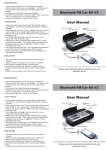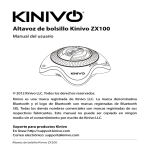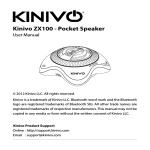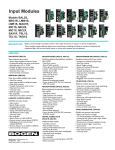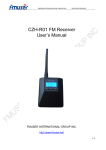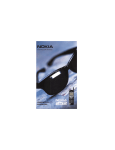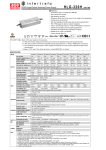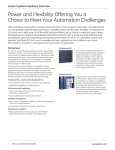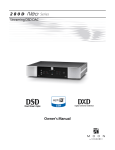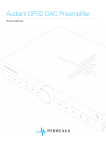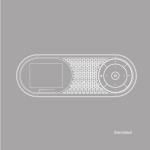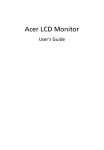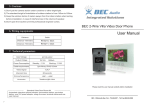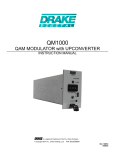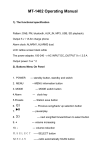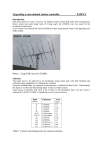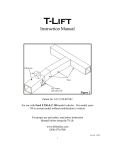Download USER MANUAL www.prolight.co.uk Order code: MIC45
Transcript
www.prolight.co.uk Order code: MIC45 – Voco Artist (863.13MHz) MIC45A – Voco Artist (863.65MHz) MIC45B – Voco Artist (864.05MHz) MIC45C – Voco Artist (864.82MHz) Order code: MIC46 - Voco Presenter (863.13MHz) MIC46A - Voco Presenter (863.65MHz) MIC46B - Voco Presenter (864.05MHz) MIC46C - Voco Presenter (864.82MHz) Order code: MIC47 - Voco Instructor (863.13MHz) MIC47A - Voco Instructor (863.65MHz) MIC47B - Voco Instructor (864.05MHz) MIC47C - Voco Instructor (864.82MHz) USER MANUAL Safety WARNING FOR YOUR OWN SAFETY, PLEASE READ THIS USER MANUAL CAREFULLY BEFORE YOUR INITIAL START-UP! CAUTION! Keep this equipment away from rain, moisture and liquids. SAFETY INSTRUCTIONS Every person involved with the installation, operation & maintenance of this equipment should: - Be competent - Follow the instructions of this manual CAUTION! TAKE CARE USING THIS EQUIPMENT! HIGH VOLTAGE-RISK OF ELECTRIC SHOCK!! Before your initial start-up, please make sure that there is no damage caused during transportation. Should there be any, consult your dealer and do not use the equipment. To maintain the equipment in good working condition and to ensure safe operation, it is necessary for the user to follow the safety instructions and warning notes written in this manual. Please note that damages caused by user modifications to this equipment are not subject to warranty. Safety IMPORTANT: The manufacturer will not accept liability for any resulting damages caused by the non-observance of this manual or any unauthorised modification to the equipment. • Never let the power-cable come into contact with other cables. Handle the power-cable and all mains voltage connections with particular caution! • Never remove warning or informative labels from the equipment. • Do not open the equipment and do not modify the equipment. • Do not switch the equipment on and off in short intervals, as this will reduce the system’s life. • Only use the equipment indoors. • Do not expose to flammable sources, liquids or gases. • Always disconnect the power from the mains when equipment is not in use or before cleaning! Only handle the power-cable by the plug. Never pull out the plug by pulling the power-cable. • Make sure that the available voltage is between 220v/240v. • Make sure that the power-cable is never crimped or damaged. Check the equipment and the power cable periodically. • If the equipment is dropped or damaged, disconnect the mains power supply immediately. Have a qualified engineer inspect the equipment before operating again. • If the equipment has been exposed to drastic temperature fluctuation (e.g. after transportation), do not switch it on immediately. The arising condensation might damage the equipment. Leave the equipment switched off until it has reached room temperature. • If your product fails to function correctly, discontinue use immediately. Pack the unit securely (preferably in the original packing material), and return it to your Prolight dealer for service. • Only use fuses of same type and rating. • Repairs, servicing and power connection must only be carried out by a qualified technician. THIS UNIT CONTAINS NO USER SERVICEABLE PARTS. • WARRANTY; One year from date of purchase. BATTERIES: The handheld microphone and bodypack transmitter can be operated with 2 x 1.5V AA batteries. Batteries are hazardous to the environment and need to be disposed of appropriately. If the unit is to be disposed of, the batteries must be removed first. Make sure that the poles are correct when inserting the battery. Leaking or damaged batteries can cause irritation when in contact with the skin. Use protective gloves before handling. Make sure that the batteries cannot be short-circuited, there is a danger of explosion. When choosing the installation site, please make sure that the unit is not exposed to extreme heat, moisture or dust. DO NOT operate the unit in exteremly hot (more than 30˚ C) or extremely cold (less than 5˚C) conditions. Keep away from direct sunlight (particularly in cars) and heaters. If the unit is operated in any way other than the ones described in this manual, the product may suffer damage and the warranty becomes void. Battery Status CAUTION! Danger of explosion when the battery is replaced incorrectly. Only replace with the same type or similar type that is recommended by the manufacturer. Remove the used batteries in accordance with this manual. Insert the batteries (2 x 1.5V AA batteries) and make sure that the poles are correct. Replace the battery cover and close it. With the “ON” “OFF” switch, you can switch the unit “ON” and “OFF”. When switching the unit “ON” the red LED flashes “ON” and then goes “OFF”. In this case the batteries are good. When the batteries are getting weak, the red LED is permanently illuminated. In this case the batteries must be replaced. If the red LED does not illuminate when switching the unit “ON”, there are either no batteries inserted or the poles are wrong. If the microphone is not in use, switch it “OFF” via the slide switch. If the unit will not be used for a long period of time, remove the batteries in order to avoid battery leakage. For extended battery life, you should use alkaline batteries. BATTERY DISPOSAL NOTICE! Please dispose of old and used batteries properly. Batteries are hazardous waste and should not be disposed of with regular domestic waste. Please take old and used batteries to a recycling unit. Approval: This wireless system was tested in accordance with the european standards EN 300422-2, EN 301489-09 and EN 60065. Consequently, this product adheres to the R&TTE directive of the european Union and does not need and individual EC type examination of every member state. The approval number CE 0678 . In the U.K, this wireless system is generally approved and license free. Receiver Functions Overview: Receiver 1: Power Indicator 2: AF Indicator 3: RF Indicator 4: Volume Control 5: Power On/Off 6 Power socket 15V DC 7: Squelch Control 8: Audio Out Socket Connections: Connect the wireless receiver via the audio output socket (8) to the input socket of your mixing desk or amplifier. Plug the connection cable of the power unit to the DC IN socket (6). Now plug the power convertor into your AC outlet. Handheld Microphone/Transmitter Functions Handheld microphone overview: Gain adjustment control The Clip Microphone Transmitter overview: Lapel/Headset Input Battery LED indicator Antenna OFF/STANDBY/ ON switch Mode Switch Gain adjustment control Belt Clip Inserting/replacing the batteries: Release the battery cover on the bottom of the microphone and remove it. Battery cover If replacing the batteries, remove the old batteries from the battery compartment and only replace with complete battery sets. Optimum Signal For optimum signal please follow these instructions: • Maintain a line of sight between the transmitter and receiver antennas. Avoid placing the transmitter and receiver where metal or other dense materials are present. • Avoid placing the receiver components near other “RF” generating equipment. Adjust the signal output level via the volume control. If the receiver is no longer in use please turn the volume control to 0 and switch the unit off IMPORTANT: Every wireless microphone installation is a unique situation, and can present a variety of problems. Never attempt a live performance without first conducting a test of the system in the performance area. if major changes (additional wireless systems or intercoms, relocation of scenery etc) have been made since the last test, check the wireless system again - as close to the performance as possible. Squelch Adjustment: The squelch control is factory preset for optimum performance. no further adjustment is normally required. However, it is possible to adjust the squelch control to emphasize either signal quality or system range. To raise the squelch threshold, rotate the control clockwise. This causes the receiver to demand a higher quality signal (less noise before muting), but it reduces the operating range. To lower the squelch threshold, rotate the control counter clockwise. This allows a lower quality signal through (more noise before muting), but it extends the operating range. Specifications System Specification: Receiving freq: ....................................................................................................................... 460-970MHz Frequency Steadying: ...........................................................<0.002% (better than 15ppm crystal control) Sensitivity: ...................................................................................................>-105dBm (S/N: -12dB/15kHz) S/N Ratio: ...........................................................................................................................................>85dB Total harmonic distortion (THD): .....................................................................................................<0.5% Frequency response: ................................................................................................50Hz – 15kHz (±2dB) Audio output: ............................................................................................................0-360mV (adjustable) Power voltage: .....................................................................................................................DC15V (±10%) Power consumption: .........................................................................................................................<10W Antenna: .................................................................................................................................Unidirectional Working distance: ..............................................................................................100M (in good conditions) Operating temperature: .....................................................................................................-10~50 degrees Dimensions: ...................................................................................................................180 x 110 x 45mm Receiver Specifications: Sensitivity: ...................................................................................................>-105dBm (S/N: -12dB/15kHz) RF image spurious rejection: ..........................................................................................................>75dB Power supply: ......................................................................................................................13.5 – 15V/DC Power consumption: .........................................................................................................................<10W Dimensions: ...................................................................................................................180 x 110 x 45mm Handheld/bodypack Transmitter Specifications: RF Power: ...............................................................................................................................10dBm (50Ω) Harmonic rejection: .......................................................................................................................>-60dBc Max. frequency deviation: ..............................................................................................................>65KHz Current consumption: ........................................................................................................<90mA (2 x AA) Cartridge: .........................................................................................................................Dynamic/Cardioid Battery: ...............................................................................................................................2 x AA (Alkaline) Battery life: .........................................................................................................Approx. 10hrs (1800mAh)








